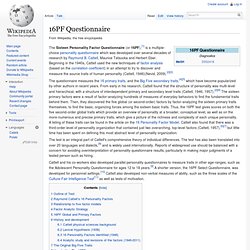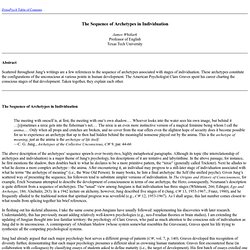

16 Personality Factors. The Sixteen Personality Factor Questionnaire (or 16PF),[1] is a multiple-choice personality questionnaire which was developed over several decades of research by Raymond B.

Cattell, Maurice Tatsuoka and Herbert Eber. Beginning in the 1940s, Cattell used the new techniques of factor analysis (based on the correlation coefficient) in an attempt to try to discover and measure the source traits of human personality (Cattell, 1946)(Nevid, 2009).[2][3] The questionnaire measures the 16 primary traits, and the Big Five secondary traits,[4][5] which have become popularized by other authors in recent years. From early in his research, Cattell found that the structure of personality was multi-level and hierarchical, with a structure of interdependent primary and secondary level traits (Cattell, 1946, 1957).[2][6] The sixteen primary factors were a result of factor-analyzing hundreds of measures of everyday behaviors to find the fundamental traits behind them.
Outline of Test[edit] Anemone's Personality Pages. ENFJ personality. Representing approximately 2 percent of all people, the ENFJ personality type tends to be very influential, often without making any conscious effort to increase their influence.

As part of the Diplomats (NF) group, ENFJs are genuinely interested in other people and radiate authenticity, concern, and altruism. Not surprisingly, those who surround ENFJs usually find them very inspiring and likeable. ENFJs are usually very charismatic and eloquent and find it natural and easy to communicate their ideas and opinions, especially in person. It does not really matter whether they are presenting cold facts or expressing raging emotions; the ENFJ will not be afraid to stand up and speak, regardless of the audience.
Everything you do right now ripples outward and affects everyone. ENFJ personalities are very intuitive. On the other hand, such intuitiveness and sensitivity can also cause significant difficulties for people with this personality type. Four Keirsey Temperaments. How Humans Are Changing the Planet—in 7 Dramatic GIFs - Rebecca J. Rosen. Watch as Las Vegas booms, the Amazon disappears, and Dubai grows out into the sea.

Google today released an "interactive timelapse experience" that allows users to explore millions of satellite images captured over the last quarter-century -- 25 years of immense growth and destruction. "We believe this is the most comprehensive picture of our changing planet ever made available to the public," Google said in a statement. The project was built in conjunction with the U.S. Geological Survey, NASA, and TIME. The images come from the USGS-NASA's satellite program LANDSAT, which were often stored on tapes like those in the thumbnail to the right. "Much like the iconic image of Earth from the Apollo 17 mission--which had a profound effect on many of us--this time-lapse map is not only fascinating to explore," Google Earth's Rebecca Moore writes, "but we also hope it can inform the global community's thinking about how we live on our planet and the policies that will guide us in the future.
" The Sequence of Archetypes in Individuation. DynaPsych Table of Contents James Whitlark Professor of English Texas Tech University Scattered throughout Jung’s writings are a few references to the sequence of archetypes associated with stages of individuation.

These archetypes constitute the configurations of the unconscious at various points in human development. The meeting with oneself is, at first, the meeting with one’s own shadow.… Whoever looks into the water sees his own image, but behind it …[s]ometimes a nixie gets into the fisherman’s net.… The nixie is an even more instinctive version of a magical feminine being whom I call the anima.… Only when all props and crutches are broken, and no cover from the rear offers even the slightest hope of security does it become possible for us to experience an archetype that up to then had hidden behind the meaningful nonsense played out by the anima.
—C. The Sixteen Personality Types. ISTJ - The Duty Fulfiller Serious and quiet, interested in security and peaceful living.

Extremely thorough, responsible, and dependable. Well-developed powers of concentration. Usually interested in supporting and promoting traditions and establishments. Well-organized and hard working, they work steadily towards identified goals. Click here for a detailed description of ISTJ. ISTP - The Mechanic Quiet and reserved, interested in how and why things work. Click here for a detailed description of ISTP. ISFJ - The Nurturer Quiet, kind, and conscientious. Click here for a detailed description of ISFJ. ISFP - The Artist Quiet, serious, sensitive and kind. Click here for a detailed description of ISFP.